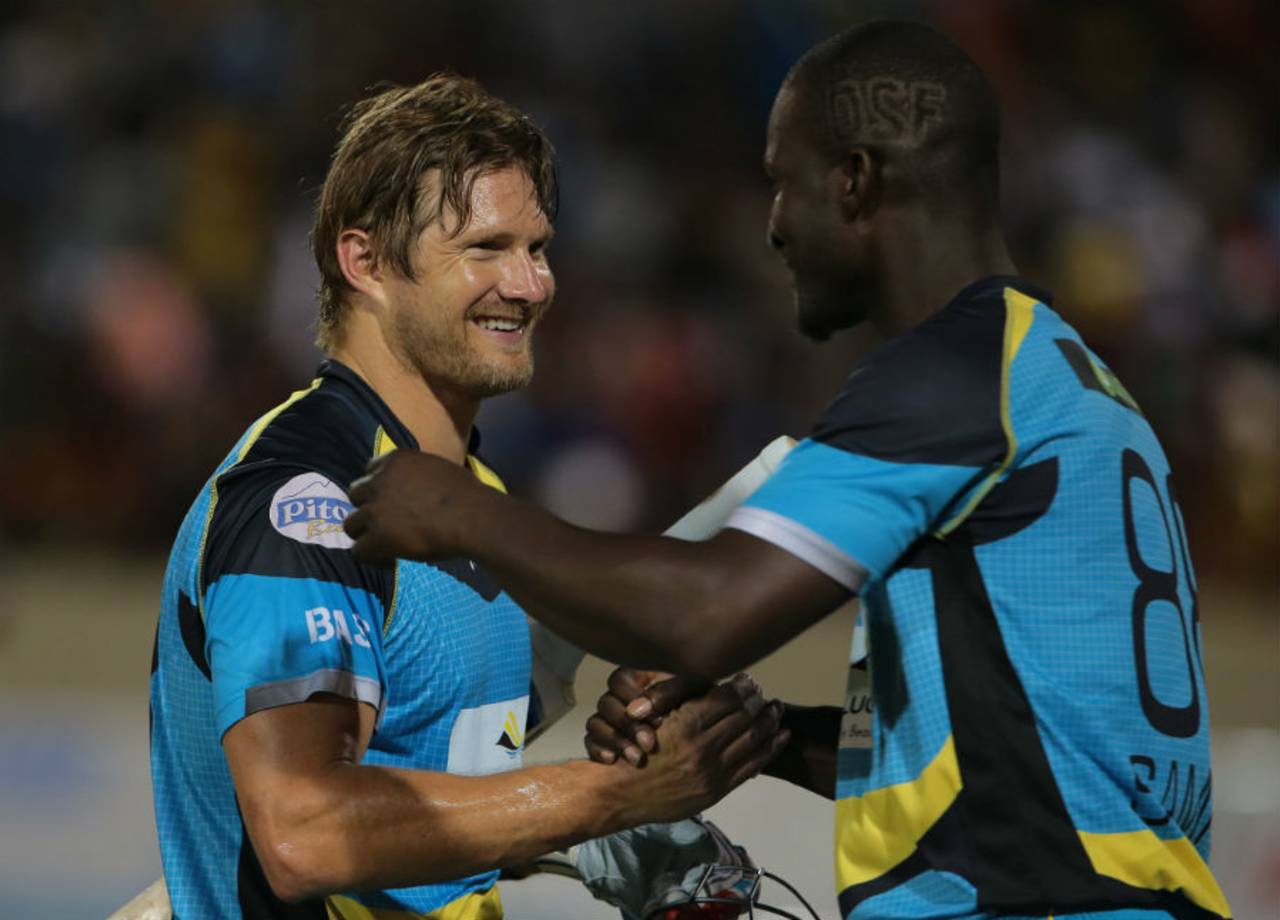What I learned watching the CPL
A few surprises from this year's tournament
Michael Jeh
08-Aug-2016

Young man's game? Veterans were to the fore in the CPL • Getty Images
Having watched a bunch of older West Indian men win the World T20 title a few months ago, I was curious about the next generation of Caribbean superstars coming through. Test cricket may be dead but was the CPL the answer to keeping the game alive and healthy in the region? So I decided to watch every game of CPL 2016.
Initially I was surprised at the abundance of overseas players, many of them now too old for international cricket but still keen to top up their superannuation coffers. Here I was looking for young local talent, but instead we had a Dad's Army comprising Chris Gayle, Dwayne Bravo, Darren Sammy, Dwayne Smith, Kumar Sangakkara, Shoaib Malik, Sohail Tanvir, Brendon McCullum, Mike Hussey, Shane Watson and Brad Hodge. With exceptions like Rovman Powell (he is special) and Evin Lewis, I saw precious few youngsters coming through to suggest that the future of West Indies cricket is rosy. Having said that, the nature of T20 cricket is such that it is entirely possible to be world champions without "owning" depth.
The other surprising thing for a competition that did such a good job of showcasing the region was the seeming lack of pride in promoting local talent; or at least providing them with the opportunity to get international exposure. The selection of umpires and match referees, for example. Why bring in foreign match officials when your own people can gain invaluable experience? Neutrality is not an issue, so why not provide opportunities to Caribbean umpires to highlight that cricket offers more career opportunities than merely playing the game. The IPL apart, do other domestic leagues fill their ranks with foreign umpires? Is this something that can be rectified to ensure the development aspect of the game extends further than just finding new on-field talent?
Even the commentary team lacked local flavour. I was looking forward to hearing those magnificent West Indian accents with local insights, but there was only one regular Caribbean voice to be heard - Daren Ganga. Some of the Australian commentators on show during the tournament are virtual unknowns even in their home country. Why not give the microphone to a few more West Indians? Importing commentators is perhaps understandable in countries where English is not the first language, but in the Caribbean?
Generally speaking, the games were played in typically Caribbean good spirit, except whenever Kieron Pollard was involved
By taking the game to the USA, the league did its best to infiltrate a niche market, but it may have gone too far by giving them a product that tried too hard to replicate baseball - the large number of rank full-tosses delivered throughout the tournament was astonishing considering we're talking of full-time professional cricketers, who presumably do very little else with their lives except practise these basic skills. My guess is that roughly 20% of balls bowled under pressure did not hit the pitch. That is a stunningly high error rate for any profession. It is one thing for batsmen like Gayle, Bravo, Andre Russell, Chris Lynn and the like to hit good-length balls into the grandstand, but when they are regularly fed knee-high full tosses, it beggars belief that this is an expression of skill at the elite end of the spectrum. This is a global pandemic and not confined to the CPL, to be fair.
You'd expect the T20 format to be the domain of the fit and the athletic, but increasingly that is not quite the case. Maybe it is the longer form of the game, albeit played at a lower intensity, where there is no room for the twin ravages of age and injury. At various stages of the CPL, Gayle, Russell, Bravo, Tanvir, Hashim Amla, AB de Villiers and Kieron Pollard were anything but 100% fit, and yet they were among the most dangerous players in the tournament. McCullum was the exception - his back injury clearly troubled him to the point where his performances with bat and in the field were compromised. The evergreen Hodge too, fine player that he was, looked like age had finally caught up with him.
The other big surprise was the abject quality of outfield catching. I base my judgement not on the few brilliant catches that will inevitably feature in a highlights reel but on the number of regulation skiers that were shelled. Trinbago Knight Riders and St Kitts & Nevis Patriots were particularly poor in this regard. While the acts of brilliance leave one breathless, I have a suspicion that maybe the sheer volume of cricket played is resulting in laziness and fatigue when it comes to these basic skills.
Generally speaking, the games were played in typically Caribbean good spirit, except whenever *Kieron Pollard was involved. Aggro seems to be his constant companion. Lendl Simmons too has a bit of that tendency in him, but the smiling elder statesmen like Sammy, Bravo, McCullum and Amla were consistently in good humour throughout.
What was revealing in regard to why West Indies are such a dangerous T20 team was the lack of interest the local players showed in trick shots: laps, reverse sweeps and the like. Most of the "cute" stuff came from the overseas players. The local lads' strategy was refreshingly simple - and perhaps offered an insight into why they are world champions, capable of chasing down any target. Clear that front leg and wait for that inevitable full toss. See ball, hit ball, hit it long, man! Just ask Ben Stokes.
*16:40:54 GMT, August 8, 2016: The article originally said Kieran Powell instead of Kieron Pollard
Michael Jeh is an Oxford Blue who played first-class cricket, and a Playing Member of the MCC. He lives in Brisbane